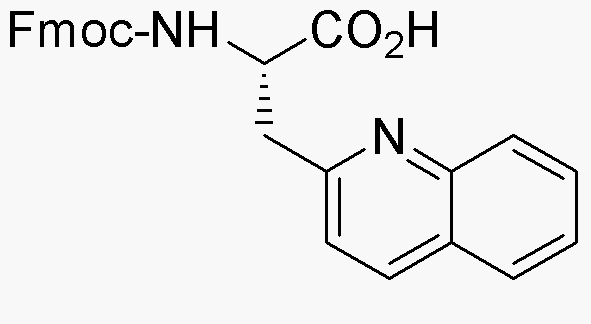Fmoc-3-(2'-quinoyl)-L-alanine is widely utilized in research focused on:
- Peptide Synthesis: This compound serves as a protective group in the synthesis of peptides, allowing for the selective modification of amino acids without affecting others. Its stability under various conditions makes it ideal for complex peptide assembly.
- Drug Development: In pharmaceutical research, it is used to create novel drug candidates, particularly those targeting specific receptors. The quinoline moiety can enhance bioactivity and selectivity, which is crucial in developing effective medications.
- Bioconjugation: This chemical is employed in bioconjugation processes, linking biomolecules such as proteins and antibodies to therapeutic agents. This application is vital in creating targeted therapies for diseases like cancer.
- Fluorescent Probes: Its unique structure allows for the development of fluorescent probes used in biological imaging. This application aids researchers in visualizing cellular processes and tracking drug delivery in real-time.
- Research in Neuroscience: The compound is explored in neuroscience for its potential neuroprotective effects. Studies suggest that derivatives may help in understanding neurodegenerative diseases and developing treatments.
General Information
Properties
Safety and Regulations
Applications
Fmoc-3-(2'-quinoyl)-L-alanine is widely utilized in research focused on:
- Peptide Synthesis: This compound serves as a protective group in the synthesis of peptides, allowing for the selective modification of amino acids without affecting others. Its stability under various conditions makes it ideal for complex peptide assembly.
- Drug Development: In pharmaceutical research, it is used to create novel drug candidates, particularly those targeting specific receptors. The quinoline moiety can enhance bioactivity and selectivity, which is crucial in developing effective medications.
- Bioconjugation: This chemical is employed in bioconjugation processes, linking biomolecules such as proteins and antibodies to therapeutic agents. This application is vital in creating targeted therapies for diseases like cancer.
- Fluorescent Probes: Its unique structure allows for the development of fluorescent probes used in biological imaging. This application aids researchers in visualizing cellular processes and tracking drug delivery in real-time.
- Research in Neuroscience: The compound is explored in neuroscience for its potential neuroprotective effects. Studies suggest that derivatives may help in understanding neurodegenerative diseases and developing treatments.
Documents
Safety Data Sheets (SDS)
The SDS provides comprehensive safety information on handling, storage, and disposal of the product.
Product Specification (PS)
The PS provides a comprehensive breakdown of the product’s properties, including chemical composition, physical state, purity, and storage requirements. It also details acceptable quality ranges and the product's intended applications.
Certificates of Analysis (COA)
Search for Certificates of Analysis (COA) by entering the products Lot Number. Lot and Batch Numbers can be found on a product’s label following the words ‘Lot’ or ‘Batch’.
*Catalog Number
*Lot Number
Certificates Of Origin (COO)
This COO confirms the country where the product was manufactured, and also details the materials and components used in it and whether it is derived from natural, synthetic, or other specific sources. This certificate may be required for customs, trade, and regulatory compliance.
*Catalog Number
*Lot Number
Safety Data Sheets (SDS)
The SDS provides comprehensive safety information on handling, storage, and disposal of the product.
DownloadProduct Specification (PS)
The PS provides a comprehensive breakdown of the product’s properties, including chemical composition, physical state, purity, and storage requirements. It also details acceptable quality ranges and the product's intended applications.
DownloadCertificates of Analysis (COA)
Search for Certificates of Analysis (COA) by entering the products Lot Number. Lot and Batch Numbers can be found on a product’s label following the words ‘Lot’ or ‘Batch’.
*Catalog Number
*Lot Number
Certificates Of Origin (COO)
This COO confirms the country where the product was manufactured, and also details the materials and components used in it and whether it is derived from natural, synthetic, or other specific sources. This certificate may be required for customs, trade, and regulatory compliance.


